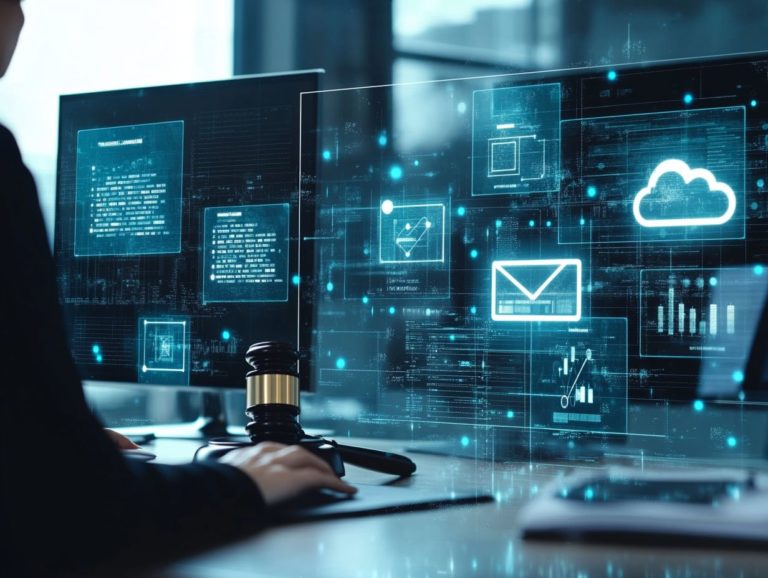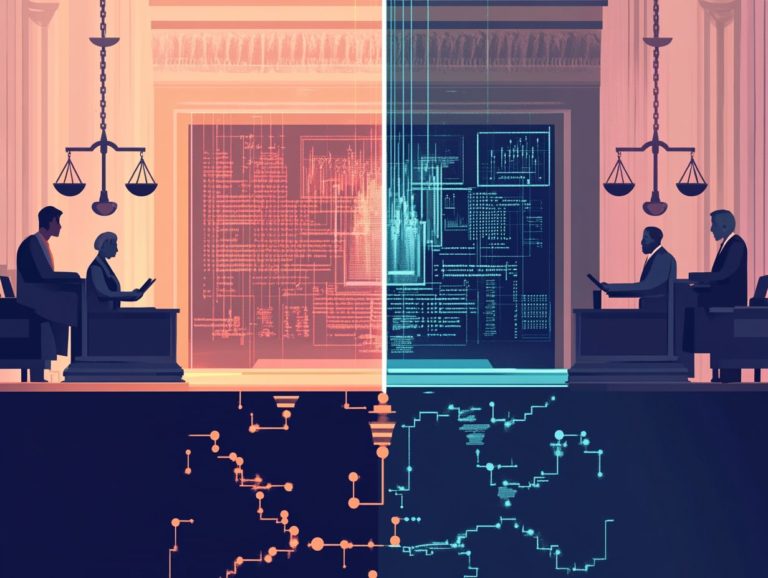5 Key Differences Between IP Litigation and Other Litigation
Are you ready to discover the unique world of intellectual property litigation? This article delves into five key differences that set IP cases apart from other legal disputes. Understanding these distinctions is essential for anyone looking to navigate the complexities of IP law.
Whether you’re a business owner, an attorney, or simply intrigued by IP, this discussion offers valuable insights to enhance your understanding.
Contents
- Key Takeaways:
- 1. Different Legal Basis
- 2. Specialized Court Procedures
- 3. Focus on Intellectual Property Rights
- 4. Different Types of Evidence
- 5. Unique Remedies and Damages
- What Is IP Litigation and How Does It Differ from Other Types of Litigation?
- What Are the Key Differences in Legal Basis Between IP Litigation and Other Litigation?
- How Do Court Procedures Differ in IP Litigation Compared to Other Types of Litigation?
- Why Are Intellectual Property Rights a Key Focus in IP Litigation?
- What Types of Evidence Are Used in IP Litigation That Are Not Used in Other Types of Litigation?
- What Are the Unique Remedies and Damages Available in IP Litigation?
- Frequently Asked Questions
- What is IP litigation?
- What are the 5 key differences between IP litigation and other litigation?
- Why is it important to understand the differences between IP litigation and other litigation?
- Do the differences between IP litigation and other litigation impact the selection of a lawyer?
- Can one lawyer handle both IP litigation and other types of litigation?
- What are some common examples of IP litigation cases?
Key Takeaways:
- IP litigation is based on specialized laws and regulations, setting it apart from other types of litigation.
- Court procedures and pre-trial stages in IP litigation often require more technical expertise.
- Intellectual property rights are central to IP litigation, emphasizing the importance of protecting these assets.
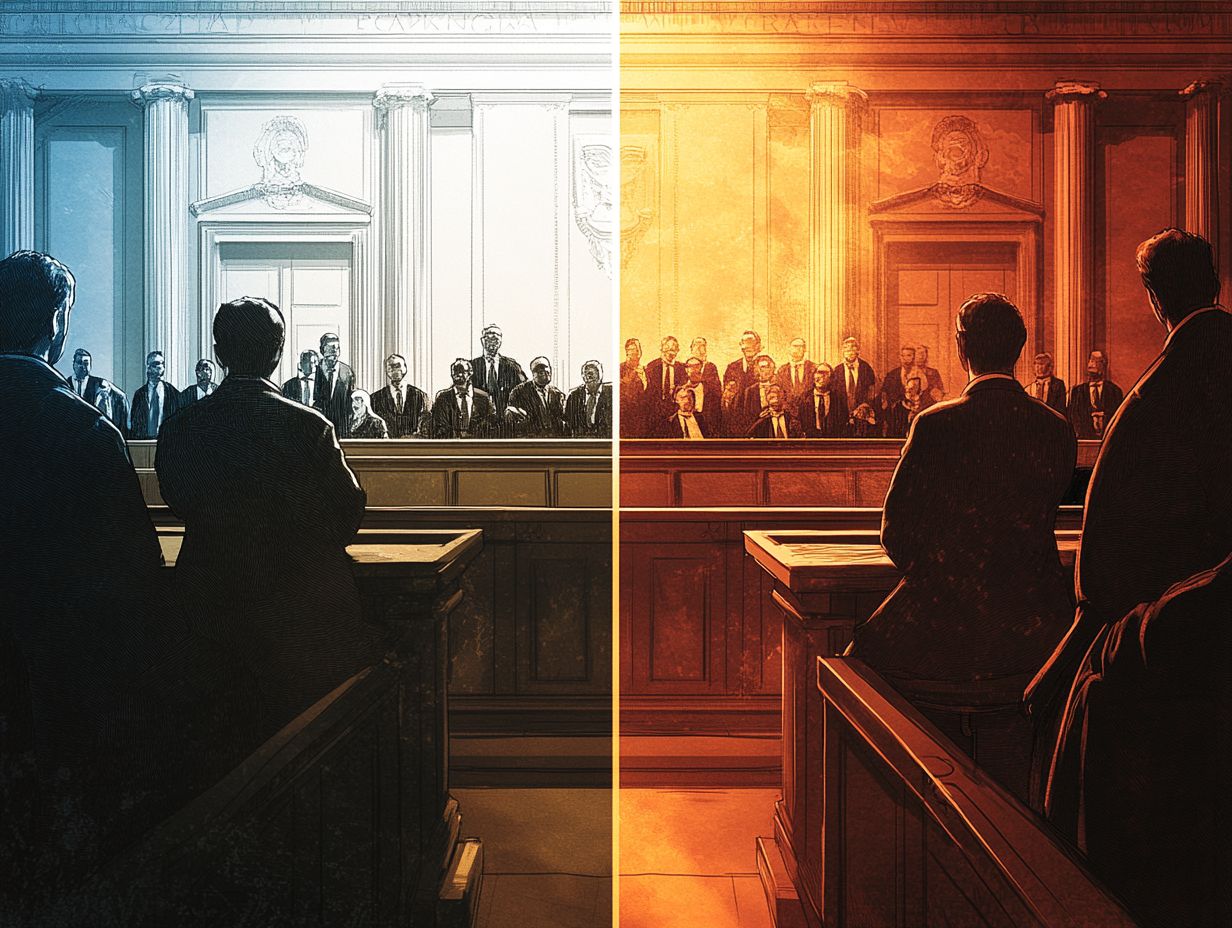
1. Different Legal Basis
The legal framework surrounding intellectual property litigation is intricate. It encompasses a variety of IP rights, such as patents, copyrights, and trademarks. Each of these is governed by specific statutes and regulations that dictate how cases are handled in both federal and civil courts.
If you’re involved in patent litigation, copyright infringement claims, or trademark disputes, understanding these distinctions is crucial. They determine the strategies employed and the legal precedents that may come into play, such as the 5 key legal resources for IP litigation.
For example, patent laws, primarily found in Title 35 of the U.S. Code, demand precise specifications and claims that must be validated in court. This often leads to complex legal battles over technical details. Copyright law, under Title 17, focuses on the original expression of ideas rather than the ideas themselves, leading to complex debates over what qualifies as fair use.
Federal regulations, shaped by key court decisions, greatly influence how cases are interpreted. Important rulings establish vital guidelines for litigation strategies, influencing everything from the damages that can be awarded to the enforcement mechanisms available to rights holders.
2. Specialized Court Procedures
In IP litigation, court procedures feature specialized processes that differ from those in other civil cases. A tailored litigation strategy, such as the 5 tips for IP litigation success, is often necessary to navigate the complexities of the trial process.
A pivotal phase you ll encounter is discovery, where both sides share important information that can heavily influence your case. This phase often leads to detailed and highly technical discussions that determine the litigation’s outcome.
Summary judgment is another important tool. It allows the court to resolve cases without a full trial when there are no material facts in dispute. This not only saves valuable time but also preserves resources.
In federal courts, unique procedural rules and standards lead to distinct strategies compared to those in state civil courts. This divergence can significantly impact litigation costs, prompting legal teams to allocate their budgets and resources thoughtfully.
3. Focus on Intellectual Property Rights
The focus of intellectual property litigation is enforcing your IP rights, which play a crucial role in protecting the economic value of your creative works. This enforcement ensures that copyright owners, patent holders, and trademark holders can take legal action against unauthorized use, whether for commercial or non-commercial purposes.
Act now to protect your rights! Safeguarding these rights not only fosters innovation but also encourages industries to invest in new ideas, technologies, and brands. When you and your business feel confident that your intellectual contributions are secure, you re more inclined to allocate resources toward further developments, ultimately driving economic growth.
On the flip side, lacking strong IP protections can lead to significant repercussions. Unauthorized use may diminish the value of your original works, causing financial losses and stifling creativity. Companies facing infringements often struggle to recover damages, resulting in decreased investments and a less competitive market overall.
4. Different Types of Evidence
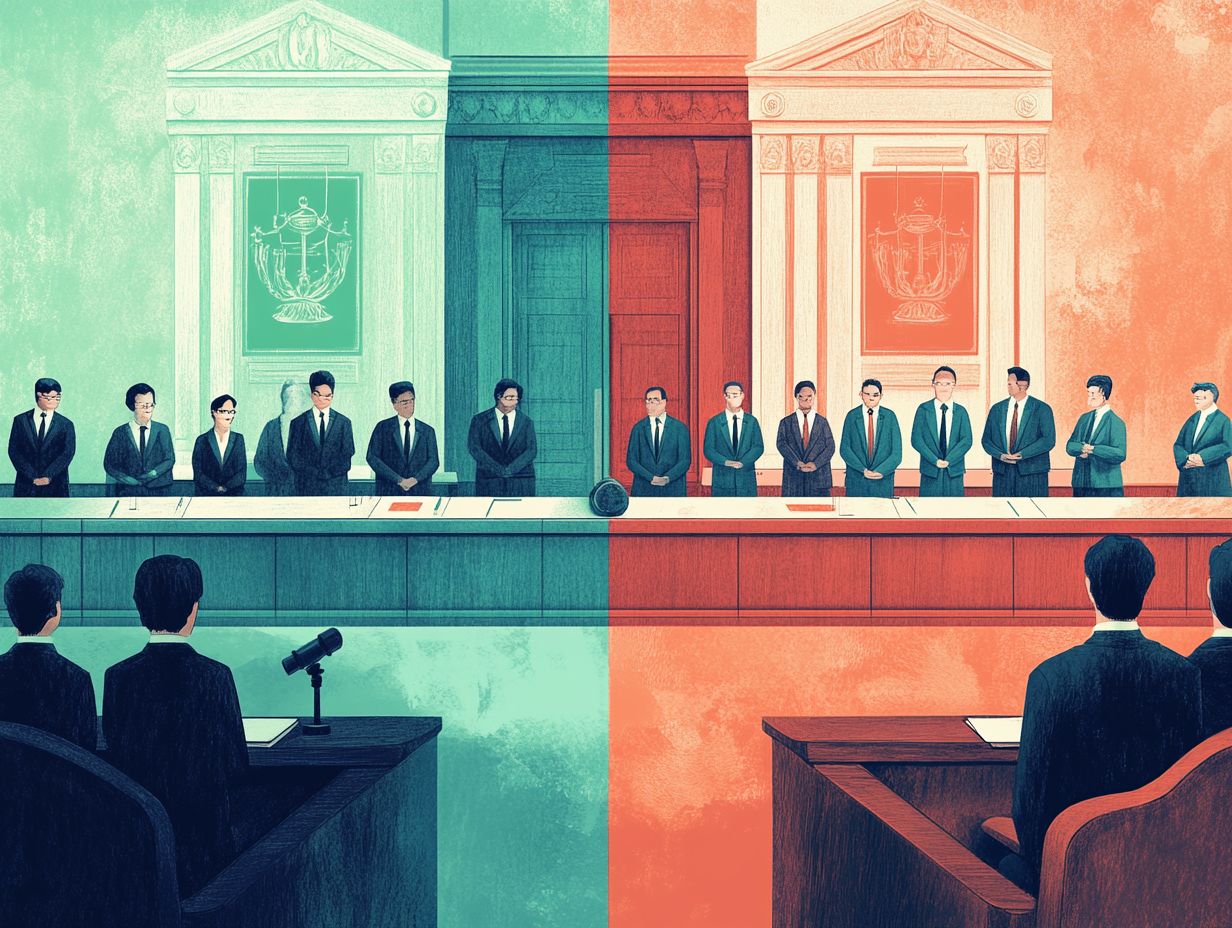
In intellectual property litigation, the evidence presented is often specialized. This includes technical documents, expert testimonies, and prior art, all crucial for proving infringement.
Technical documents may contain complex diagrams or coding sequences. Analyzing these is essential to show that one product unlawfully replicates another’s patented technology.
Expert testimonies are vital to explain complicated scientific concepts to judges and juries. They may lack the necessary background in these fields.
Legal expertise is invaluable here. Effectively interpreting specialized evidence helps communicate the nuances of intellectual property clearly and persuasively.
5. Unique Remedies and Damages
In intellectual property litigation, remedies and damages are unique. They often include damages set by law, injunctions to stop unauthorized use, and recovery of your legal fees.
If willful infringement occurs, you can pursue enhanced damages. This shows how seriously the legal system views these violations.
Settlement negotiations are crucial. They often lead to tailored agreements that provide monetary compensation and a clear path for compliance.
What Is IP Litigation and How Does It Differ from Other Types of Litigation?
Intellectual property litigation is about enforcing IP rights. This includes patent litigation, copyright infringement, and trademark disputes.
These areas follow specific legal frameworks, which makes them different from other types of litigation. To effectively navigate this complexity, being aware of recent trends in IP litigation is essential for success.
Patent cases often involve intricate technical details. Copyright issues focus on the nuances of creative expression, which is key for developing effective legal strategies.
Being well-informed is crucial in this specialized legal arena. It helps protect your rights effectively.
What Are the Key Differences in Legal Basis Between IP Litigation and Other Litigation?
The legal foundation for intellectual property litigation is distinct. It’s shaped by specific statutes and federal regulations governing IP rights.
This framework sets different standards compared to other types of litigation. Specialized regulatory bodies like the U.S. Copyright Office and Patent and Trademark Office influence this environment.
These organizations oversee applications and registrations and provide guidance that significantly impacts legal interpretation. They define what constitutes infringement and fair use.
How Do Court Procedures Differ in IP Litigation Compared to Other Types of Litigation?

Court procedures in IP litigation have a unique structure that requires specialized strategies. For effective outcomes, it’s crucial to implement key strategies for successful IP litigation. The trial process demands a distinct approach, including specific discovery phases crafted to address the complexities of intellectual property cases.
These intricacies stem from the nature of intellectual property rights. They require meticulous attention to detail and an understanding of both legal and technical facets that aren’t typically encountered in general civil litigation, as highlighted in the 5 key takeaways from recent IP litigation cases.
In federal courts, you may engage in specialized motions and present expert testimonies that illuminate the innovative aspects of intellectual property. For deeper insights, consider exploring lessons learned from major IP litigation cases. In contrast, general civil cases usually revolve around broader legal principles.
This differentiation highlights the need for a solid understanding of IP-specific regulations and practices. By doing so, you can efficiently navigate the multifaceted landscape of litigation, especially by exploring 5 ways to leverage IP rights in litigation in these specialized arenas.
Why Are Intellectual Property Rights a Key Focus in IP Litigation?
Intellectual property rights are crucial in IP litigation because they grant exclusive rights that nurture innovation and creativity. Enforcing these rights safeguards the economic value of creative works and allows recovery of damages in cases of unauthorized use.
These rights allow you as an individual or a company to invest your time and resources into developing new ideas, with the confidence that your innovations will be protected from infringement.
Consider a tech startup like yours that boldly launches a groundbreaking app, shielded by patents and copyrights. With this protection, your innovative app could open doors to amazing financial success!
On the flip side, when these rights are compromised, the economic fallout can be catastrophic, stifling growth and deterring future investments. Pursuing restitution for damages gives you power, serving as a safety net for creators and bolstering market integrity.
This ensures that innovation flourishes within a secure and competitive landscape, ultimately benefiting everyone involved.
What Types of Evidence Are Used in IP Litigation That Are Not Used in Other Types of Litigation?
In IP litigation, the types of evidence used often include:
- Technical evidence
- Industry standards
- Expert witnesses
These elements underscore the specialized nature of the strategies employed. Technical evidence is key in this realm, often requiring a nuanced understanding of specific technologies or methodologies.
For example, patents may rely on intricate diagrams and formulas, necessitating thorough explanations. Industry standards act as benchmarks for defining innovation or infringement, shaping arguments presented in court.
Expert witnesses play a critical role, translating complex concepts into terms that juries can easily understand. Their credibility and specialization can greatly influence jurors’ perceptions, ultimately impacting the outcome. Their testimony is an essential element in the IP litigation process.
What Are the Unique Remedies and Damages Available in IP Litigation?
The remedies and damages available in IP litigation are distinctive. They range from statutory damages to injunctions specifically designed to address the nuances of intellectual property infringement and legal fees incurred by plaintiffs.
These remedies aim to compensate the injured party and serve as a deterrent for potential infringers who might consider undermining innovative works. Unlike general tort law, where damages often focus primarily on compensatory relief, IP litigation emphasizes preventing further infringement. Injunctions can immediately stop any unauthorized use.
Statutory damages offer a streamlined way to claim compensation without the burden of proving actual harm. This simplifies the recovery process significantly and highlights the vital role that intellectual property rights play in nurturing creativity across diverse industries.
Frequently Asked Questions
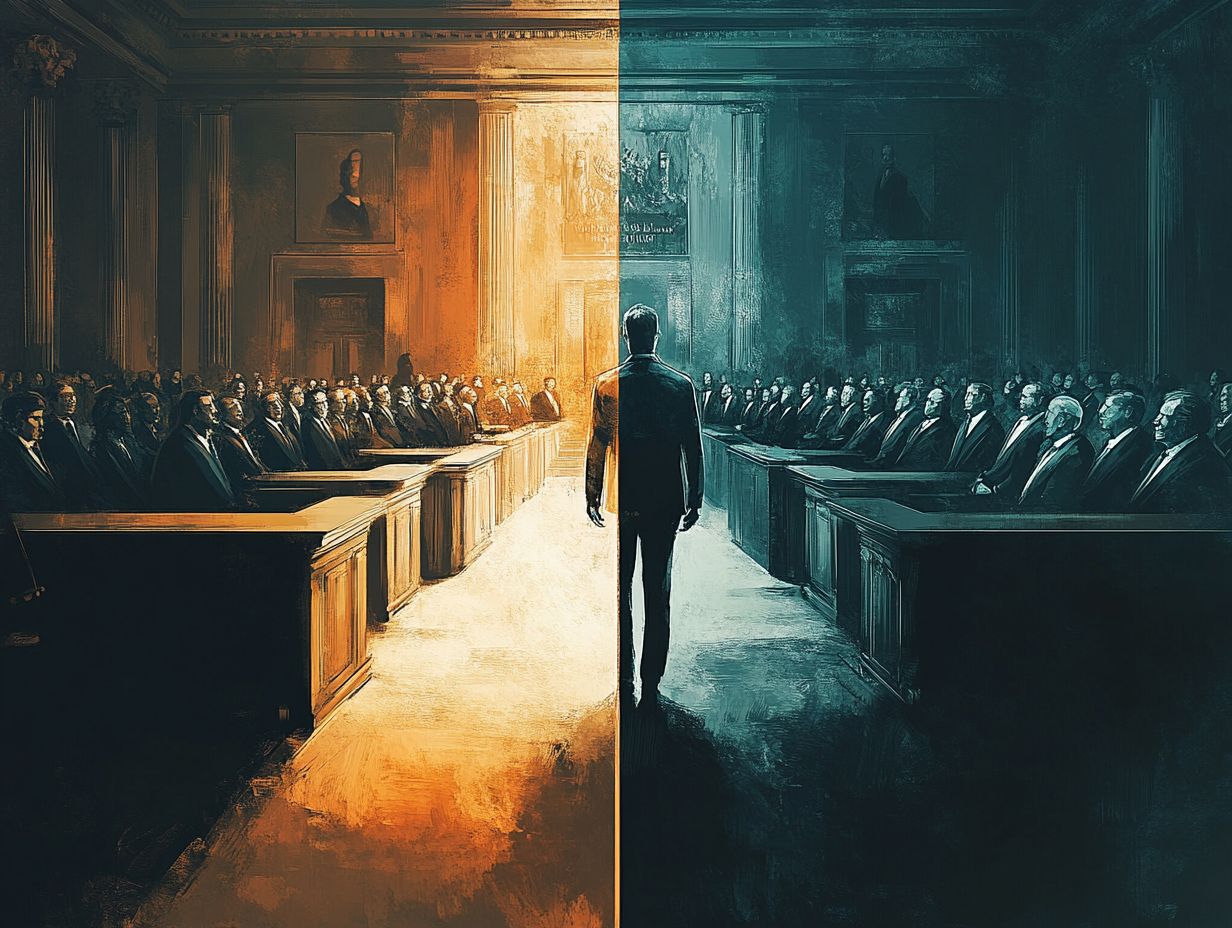
What is IP litigation?
IP litigation involves legal disputes related to intellectual property rights. These rights protect ideas and creations like inventions, brands, and artistic works.
What are the 5 key differences between IP litigation and other litigation?
- Subject matter: IP litigation focuses on disputes over intellectual property rights. Other litigation can cover many legal issues.
- Specialized laws: IP litigation is governed by unique laws and procedures, making it a specialized area of law.
- Knowledge needed: This type of litigation often requires specialized knowledge in intellectual property.
- Time and cost: IP cases can be time-consuming and expensive due to their complexity.
- Resolution options: IP disputes can also be resolved through methods like arbitration or mediation.
Why is it important to understand the differences between IP litigation and other litigation?
Knowing these differences is crucial! They can greatly impact your strategy and approach to resolving disputes.
Do the differences between IP litigation and other litigation impact the selection of a lawyer?
Yes! Choosing a lawyer who specializes in intellectual property can lead to better outcomes for your case.
Can one lawyer handle both IP litigation and other types of litigation?
While some lawyers may work in both areas, it’s best to choose one who specializes in the specific type of litigation you need.
What are some common examples of IP litigation cases?
Common IP litigation cases include disputes over patent infringement, trademark infringement, copyright infringement, and trade secret theft.




